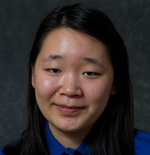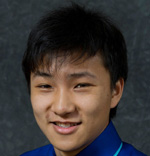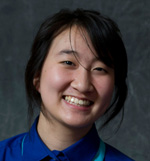January 9, 2012 - By Rosanne Spector

Angela Zhang
Thanks to a couple of Palo Alto teenagers, pediatricians may be getting a test that quickly reveals which of two deadly lookalike conditions is sickening a newborn.
And the work of another youth from Cupertino has resulted in a design for what one scientist called “a Swiss army knife for cancer treatment” — a multifunctional nanoparticle that combines treatment and imaging in a single unit.
The three students, who were mentored by Stanford researchers, won prizes in the Siemens Competition in Math, Science and Technology, which announced the winners in December — six individuals and six teams.
The students’ accomplishments boggle the mind, unless you work regularly with high school students with a passion for science.
“I hold a deep conviction that young people have capacities far beyond what society typically expects,” said professor of surgery Jill Helms, DDS, PhD, who regularly mentors high school student interns. “If you put them in a situation where their creativity and inventiveness can manifest itself, you’ll be completely and totally amazed.”

Jeffrey Ling
The Cupertino winner, a high school senior by the name of Angela Zhang, took the top prize for individual entrants: a $100,000 scholarship. Angela was a scientist at heart well before high school. Even as a little girl, said her mother, Jenny Wu, Zhang loved getting to the bottom of puzzles posed by her father, an engineer, such as why water heats up so fast in hotels but takes longer at home.
“But what was most inspiring was two years ago when she took part in the Intel science fair in Santa Clara and saw other people interested in science like her,” Wu said.
Her interest led her to the lab of assistant professor of radiology Zhen Cheng, PhD, where after school she observed the scientists at work and listened in at lab meetings and talks in 2009. She went on to do hands-on work as an intern in the summer of 2010, learning to make nanoparticles — one of Cheng’s areas of expertise. She completed an additional summer internship, at National Institutes of Health, in 2011.
“In my lab, she focused on the nanoparticle preparation. You need to know how to make the particle and make surface modifications to suit your purpose, and make it biocompatible,” Cheng said.
Zhang learned how to carry out the chemical reactions and started planning a nanosystem that would work to treat cancer and image the treatment’s outcome. The result was a design for a tiny machine made of paired gold and iron oxide nanoparticles to deliver chemotherapy directly to cancer stem cells. A magnet applied to the tumor site can pull the iron oxide particles into place, peptides coating the particles help assure they bind to biomarkers on cancer stem cells, and the gold and iron oxide show up clearly using various imaging techniques including MRI. To top it off, the release of the drug would be controlled by laser beam. Zhang tested the imaging and drug release system in mice.

Helen Jiang
“She’s at quite a high level of research,” said Cheng. “It’s not easy for a high school student.”
Just back from the award ceremony at George Washington University, in Washington, D.C., Zhang explained what keeps her interested in science: “Recent innovations have been so inspiring and cool that I can’t help but feel motivated. I often say that research these days is more amazing and innovative than the advancements that are created by the worlds of science fiction.”
Zhang has been accepted at Stanford, and plans to enroll as a freshman next fall.
The Palo Alto winners, Gunn High School’s Helen Jiang and Palo Alto High School’s Jeffrey Ling, were mentored by associate professor of surgery Karl Sylvester, MD, and won $10,000 for scholarships in the team competition. They attended lab meetings and listened in on discussions when Sylvester called them in, so they could see the problem in 360 degrees.
“They are very advanced in math, and they have the ability to do some programming, a lot of energy, enthusiasm and curiosity,” said Sylvester.
Ling is captain of a Science Olympiad team and a 2011 USA Junior Mathematical Olympiad winner. Although he’s a junior in high school, he has taken Stanford math classes too. He first became interested in math in sixth grade, when he discovered “how tricky mathematics is.”
It was at a math camp that he and Jiang met. He hopes to become an inventor and “create something interesting and worthwhile that can benefit the lives of everyone in the world.”
Part of the inspiration for Jiang’s work on the project was her experience staying with her younger sister in the hospital when she broke her arm. That fed an interest in finding ways to help children born with diseases that forced them to stay in hospitals for long periods of time. Jiang loves math too. “I love how the real world is incorporated into a statistics class,” she said.
For their project, the students wrote a computer program that allows scientists to use a blood or urine test to determine whether a newborn is suffering from necrotizing enterocolitis or from sepsis, which have similar symptoms. “Their code enabled us to detect meaningful differences from mass spectrometry data,” said Sylvester. “It’s a great accomplishment.” The test will go through a validation trial at leading U.S. children’s hospitals in the next year, he said.
About Stanford Medicine
Stanford Medicine is an integrated academic health system comprising the Stanford School of Medicine and adult and pediatric health care delivery systems. Together, they harness the full potential of biomedicine through collaborative research, education and clinical care for patients. For more information, please visit med.stanford.edu.